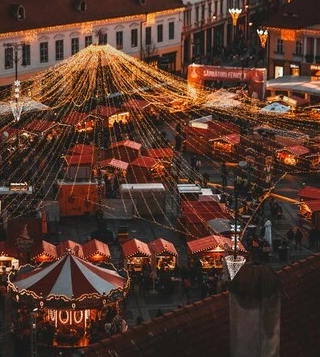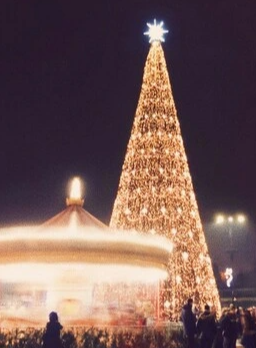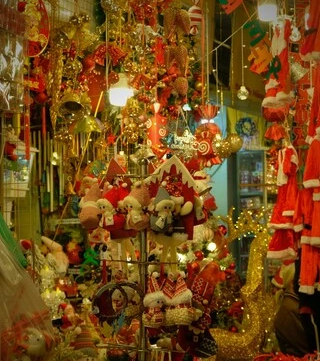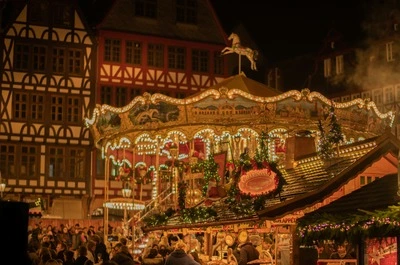Last updated: 30.10.2025
Reading time:
12
Minutes
Romania may not be the first country that comes to mind when planning an Advent trip. But anyone who sets out in the weeks before Christmas to discover this diverse country between the Carpathians, Transylvania, and the Black Sea will be richly rewarded: festively decorated old towns, atmospheric squares, handmade crafts, hearty home-style cuisine, and an ambiance that shimmers between mountain romance, Central European tradition, and Balkan melting pot. Christmas markets in Romania are often smaller than those in Vienna or Munich, but that’s exactly what makes them more personal and authentic.
To make the journey as relaxed as your stroll through the markets, drivers should plan for the digital Rovinietă (vignette) for Romania. It is mandatory on national and European roads outside built-up areas, can be conveniently purchased online, and is valid immediately or from your preferred start date. Depending on your route, additional special tolls may apply (e.g., Danube bridges).
Advent Market in Sibiu (Hermannstadt)

The historic “Piața Mare” turns into a sea of lights during Advent: a sparkling canopy of lights spans the square, the ice rink, and the Ferris wheel. They create a magical winter atmosphere and bathe the city in a unique glow. The wooden chalets offer Transylvanian handicrafts and delicious foods such as cabbage rolls (sarmale), polenta (mămăligă), and sweet braided loaves (cozonac). Experience the Christmas spirit in Sibiu and take a ride on the romantic Ferris wheel. From there, you’ll catch a unique view of the Advent market and escape the hustle and bustle for a few minutes. Afterwards, warm up with a tasty mulled wine—perfect together with one of the classic sweet braided loaves!
- Opening times: Sibiu’s Advent market usually begins in mid/late November and runs until early January. Check the daily opening hours before you go, as they may vary by weekday.
- Getting there: From Germany and neighboring countries, the most comfortable route usually leads through Austria and Hungary to Romania. After Vienna, continue east via Budapest. From Szeged, the M43 takes you to the Nădlac II border crossing. After entering, follow the A1 towards Arad, Timișoara, and Deva. From there continue on the connection to Sibiu. Large sections are built like a motorway. Depending on the section, expect speed limits and possible construction. In winter, plan extra time, as it can get dark early and slippery in Transylvania. It’s best to park in the edge-of-old-town parking garages; from there it’s only a few minutes’ walk to “Piața Mare.”
Christmas Markets in Bucharest

In the capital, the Christmas heart beats at Piața Constituției, right in front of the impressive Palace of Parliament. A large Christmas tree, closely lined chalets, a stage with choirs and bands, and a dedicated children’s area define the scene. Enjoy a delicious mulled wine that will warm more than just your body. Here too, strings of lights span the market and create a unique picture. Let the glittering lights work their magic and savor one of the country’s tasty traditional dishes. The Christmas Markets in Bucharest are definitely a highlight you do not want to miss out. Do not forget to take some pictures as a memory of your trip!
- Opening times: The Christmas market season in Bucharest begins in late November and can run until late December/early January. Daily opening hours may vary by weekday. Evening illuminations and stage programs are especially atmospheric. Please check the schedule before your visit.
- Getting there: From Germany and neighboring countries, the simplest route usually leads through Austria and Hungary to Romania. After Vienna, continue east via Budapest. From Szeged, Hungary’s M43 takes you to the Nădlac II border crossing. After entering Romania, follow the A1 via Arad, Timișoara, Deva, and Sebeș. Then continue toward Sibiu. Near Pitești, rejoin the A1, which takes you directly to Bucharest.
Christmas Market in Cluj-Napoca

Cluj celebrates the Christmas season right on Piața Unirii, set against the backdrop of the Gothic St. Michael’s Church. A canopy of lights stretches across the square, complemented by attractions such as a Ferris wheel, a children’s carousel, and the “Căsuța lui Moș Crăciun” (Santa’s House). Numerous stalls from regional vendors invite you to browse crafts, sweets, and gifts.
Conveniently, cafés and restaurants surround the square, making it easy to warm up. Culinary favorites include stuffed flatbreads and hot apple mulled wine/cider—perfect for rounding off your visit with a treat.
- Opening times: Typically late November to New Year’s. Children’s programs take place in the afternoon, and from dusk you can enjoy shows and live music.
- Getting there: The most comfortable drive to Romania usually leads through Austria and Hungary: from Munich/Salzburg via Vienna to Budapest, then on Hungary’s expressways toward Oradea (Nagyvárad). The frequently used Borș II border crossing connects the M4 directly to Romania’s A3, which quickly brings you to Cluj-Napoca. Plan sufficient breaks and expect demanding conditions in winter. Keep in mind that it gets dark early in the Carpathians and some sections can be slippery.
Insider Tip: Oradea

Oradea is the relaxed counterpoint: around Piața Unirii and nearby Piața Ferdinand, carefully restored Art Nouveau and Secession façades set the scene. Chief among them is the impressive Palatul Vulturul Negru (Black Eagle Palace) with its glass arcade. Distances are short, the historic center is compact and walkable, and in the evening the atmospheric lighting of the squares creates a calm, festive mood.
During Advent, the squares regularly turn into stages for sparkling lights, musical programs, and family-friendly offerings. If you prefer to avoid crowds, you’ll find a laid-back alternative to overcrowded markets here—perfect for anyone wanting to enjoy Christmas flair in a beautiful setting without the jostling.
- Opening times: The Christmas spirit usually fills Oradea from late November until after Christmas. Concerts and choir performances take place mainly in the evening.
- Getting there: Travelers from Germany or neighboring countries usually take the route via Austria and Hungary. After Vienna, head east via Budapest. From there, Hungary’s M3/M35 lead toward Debrecen and then the M4 takes you directly to the Borș II border crossing. After entering, Romania’s A3 continues; from here it’s only a few kilometers into the city. Note that toll requirements differ by country. For example, each country has its own vignette—an Austrian vignette does not cover Hungary, so you’ll also need a Hungarian vignette.
Tips for Your Trip Planning
- Timing: Late morning to early afternoon (approx. 11:00–15:00) is when Romania’s markets are quietest—ideal for browsing and photography. From dusk (approx. 16:00–18:00), things get especially atmospheric; if possible, avoid Saturday evenings.
- Route & planning: Cluster destinations within one region, e.g., Transylvania with Sibiu–Brașov–Cluj or the western route with Timișoara–Oradea. Check event calendars (concerts, nativity plays) and choose accommodations within walking distance of the old town or near park-and-ride.
- Arrival & traffic: In the Carpathians (e.g., Prahova Valley toward Brașov), you may encounter traffic jams and wintry road conditions. Build in buffers, use winter equipment, and note that high mountain roads like the Transfăgărășan are closed in winter.
- Clothing: Dress in layers, windproof jacket, hat, gloves. Comfortable, waterproof shoes are essential (slippery cobblestones!). Pack a power bank and a reusable cup for mulled wine/tea to go.
- Parking: Park in guarded garages at the edge of the old town and walk the last few minutes. In big cities, pay attention to designated zones; don’t leave valuables visible in the car.
- Food & drink: Try sarmale (cabbage rolls), mici (grilled minced rolls), păpănași (cheese doughnuts), cozonac (sweet braided loaf), kürtőskalács (chimney cake), and vin fiert (mulled wine). Off the main streets you’ll often find more authentic, better-value stalls.
Why You Need a Digital Vignette in Romania
The vignette (Rovinietă) is mandatory on national and European roads outside built-up areas for passenger cars, motorhomes, and—depending on category—heavier vehicles. It’s linked to your license plate, can be booked online, and is valid immediately or from your chosen start date. Checks are automated in Romania. Those who drive without a vignette risk fines. Additional special tolls (e.g., for Danube bridges) may apply and are charged separately. You must pay these regardless of the vignette. Note that vignettes are country-specific. If you travel to Romania via Austria or Hungary, you’ll need a separate vignette for each country.
Your benefits when buying a vignette from us: simple digital ordering, selectable preferred start date, 15-language email support, and transparent validity periods. Ideal for a weekend getaway or an extended winter trip.
The DMC Team Wishes You a Wonderful Trip!
Whether you’re strolling through Bucharest’s atmospheric market, experiencing Sibiu’s sea of lights, enjoying the magical vibe in Cluj-Napoca, or discovering our insider tip Oradea: each of these places offers a unique Advent feeling. To ensure a smooth journey, secure your digital vignette for Romania from us in advance. You’ll save time, avoid stress, and can fully focus on the Advent spirit.
FAQ: Questions About Romania’s Christmas Markets
Yes. As soon as you use national or European roads outside of towns, a digital vignette is mandatory. It’s linked to your license plate and valid immediately or from your preferred start date.
For an Advent weekend, the 7-day vignette is usually sufficient. If you combine several cities, choose 30 or 90 days; frequent drivers benefit from the annual vignette.
Yes. Special tolls (e.g., certain Danube bridges) apply in addition to the vignette and are billed separately.
Validity is
checked digitally via license plate matching. Driving without a vignette can result in substantial
fines. Retroactive activation is not possible. Therefore, feel free to purchase your
digital vignette from us now.
Yes. You can get the digital vignette from us online in just a few steps—either activated immediately or with your preferred start date.
No. Vignettes are country-specific. At DMC you can also obtain digital vignettes for Austria, Slovenia, Hungary, Czechia, Slovakia, and Switzerland—ideal for cross-border Advent road trips.
English






